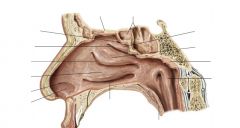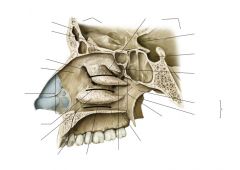![]()
![]()
![]()
Use LEFT and RIGHT arrow keys to navigate between flashcards;
Use UP and DOWN arrow keys to flip the card;
H to show hint;
A reads text to speech;
25 Cards in this Set
- Front
- Back
|
What is the innervation of the sublingual salivary gland... what other thing is it similar to? describe the parasympathetic innervation
|
similar to submandibular gland-->
Preganglionic parasympathetic fibers from superior salivatory nucleus exits brainstem with facial VII n. and terminates in submandibular ganglion, the post ganglionic parasympathetic fibers from submandibular ganglion distribute as short branches to parenchyma of gland - |
|
|
describe the parasympathetic innervation path to the sublingual gland
|
post ganglionic sympathetic fibers originate in the superior cervical ganglion and reach gland by coursing the external carotid plexus, facial plexus or sublingual plexus... which courses in the adventitia of the sublingual branch of the lingual artery
|
|
|
describe the relationship between the lingual nerve and submandibular duct
|
Lingual nerve spirals around the submandibular duct from superior-lateral to inferior-medial
- duct will be above the nerve in the dissection of the floor of the mouth |
|
|
Describe the important innervation of the tongue...and origins (embryo)
|
a. anterior 2/3 from ectoderm is innervated by Trigeminal V - pain, temp, touch (GSA) and facial VII - taste- (SVA)
b. posterior 1/3 from endoderm innervated by glossopharyngeal Glssopharyngeal IX GVA and SVA c. intrinsic muscle derived from head of myotomes GSE from hypoglossal n (xii) |
|
|
What are the two regions of the dorsum of the tongue?
|
dorsum has ...
1. oral (anterior 2/3) 2. pharyngeal (posterior 1/3) divided by sulcus terminalis reflecting different embryological origins |
|
|
Describe the route of lymphatic drainage of the tongue
|
Drains into paracervical lymps but eventually deep cervical which is important due to cancer
|
|
|
Describe how you might find deviation of the uvula toward one side...
|
paraylysis of the tensor or levator palate muscles on the non-paralyzed side pull the uvula toward normal side
|
|
|
describe the relationships of palatine tonsil... what is its clinical correlation
|
located between palatoglossal and palatopharyngeal folds in the tonsilar fossa
- its a lymphatic gland that drains into the tonsillar nodes |
|
|
Explain how blood leaves this area and how this is clinically relevant
|
venous drainage of palatine tonsil is mainly the tonsillar vein into the pharyngeal venous plexus and facial vein. The tonsillar vein is a frequent bleeder during tonsillectomy
|
|
|
NAme the three nerves and vessels to the palate and how they distributed...
|
nasopalatine- post invisive
greater palatine- hard palate lesser palatine- soft palate |
|
|
Tensor veli palatini m. located where:
b. inserts? c. innervation d. action? |
a. located anteriolateral to levator palati muscle and auditory tube
b. inserts on soft palate c. innervated by small branch of mandibular nerve (V).. d. opens auditory tube |
|
|
a. Levator veli palaitini m. located where?
b. origin and insertion? c. innervation d. action |
a. inferior to the auditory tube on lateral wall of nasopharynx
b. originates inferior surface of petrouss temporal bone and part of auditory tube inserts in soft palate c. vagus d. elevator of soft palate |
|

|

|
|
|
What is the innervation and blood supply to the nasal cavity?
|
made of two halves, with a roof, floor and medial and lateral wall
|
|
|
Where do fractures frequently occur in the nose?
|
at the junction between septal cartilage and the ethmoid and vomer bones
- |
|

|

|
|
|
What do the conchae act as in the nose and what do they do?
|
they are scroll like projections located in the lateral nasal wall they forms gutters called meatuses and increase surface area of the cavity and humidify and warm inspired
|
|
|
What is the blood supply to the nasal cavity?
|
sphenopalatine artery (terminal branch of maxillary a., supplies septum and lateral wall of the posterior one half of the nasal cavity
- anterior 1/3 is supplied by the anterior ethmoidal a. (branch of opthalmic a.) |
|
|
What is the nerve supply to the nasal cavity?
|
1. posterior 2/3- branches of the sphenopalaitine ganglion (pterygopalatine) supply GVA and autonomic
2. anterior 1/3 anterior ethmoidal n. (V1) 3. Olfactory I nerves |
|
|
Where do epistaxis (nasal hemorrhages) occurs where usually?
|
septal branches of the superior labial and sphenopalatine arteries
aka Kiesselbach's area |
|
|
1. Which sinus arises at birth?
2. What does the roof of maxillary sinus form? Floor? 3. drainage? 4. Maxillary sinusitis may cause what type of pain? |
1. maxillary
2. roof is floor of orbit and floor is alveolar part of maxilla 3. drains into the hiatus semilunaris 4. molar tooth pain, and can be an area of spread of tooth infectoin |
|
|
Why is the relationship of maxillary sinus to orbit important?
|
V2 infraorbital n. groove for infraorbital sulcus in skull and roof of maxillary sinus is orbit
|
|
|
Why is maxillary and sphenoidal sinus important clinically?
|
used as surgical approach to get to the pituitary
|
|
|
IMPORTANT: What is located in relation to the sphenoidal sinus...
a. posterior b. superior c. anterior d. inferior e. lateral |
a. pons, basilar artery
b. pituitary c. nasal cavity d. nasopharynx e. internal carotid, V1, cavernous sinus |
|
|
describe the major arteries and clinical stuff arising from the maxillary a.
|
1. madibular portion-
middle meningeal (most often damaged in temporal bone fractures causing epidural hematomas) inferior alveolar- mandible teeth and gingiva 2. Sphenopalatine- supplies nasal cavity |

